Strategic Supply Chain Management: Last Mile Delivery Issues in India
VerifiedAdded on 2023/06/10
|13
|1031
|247
Report
AI Summary
This report delves into the complexities of last mile delivery within the Indian e-tailing industry, highlighting the differences between traditional and electronic supply chain management. It identifies key components such as first mile delivery, fulfillment, processing and sorting, line hauling, and the crucial last mile delivery itself. The report outlines the growth of the Indian online segment, its major players like Flipkart and Amazon, and the unique challenges faced, including delivery returns, errors, lack of technology, and payment method issues like cash on delivery. Recommendations are provided, focusing on the adoption of IoT, Artificial Intelligence, and automated parcel delivery terminals to optimize processes and improve customer retention. The report concludes that while the Indian e-tail sector has made significant progress, addressing infrastructure and technological gaps is crucial for future growth and success in last mile delivery.

E-tailing
Last mile delivery issues in
India
Last mile delivery issues in
India
Paraphrase This Document
Need a fresh take? Get an instant paraphrase of this document with our AI Paraphraser
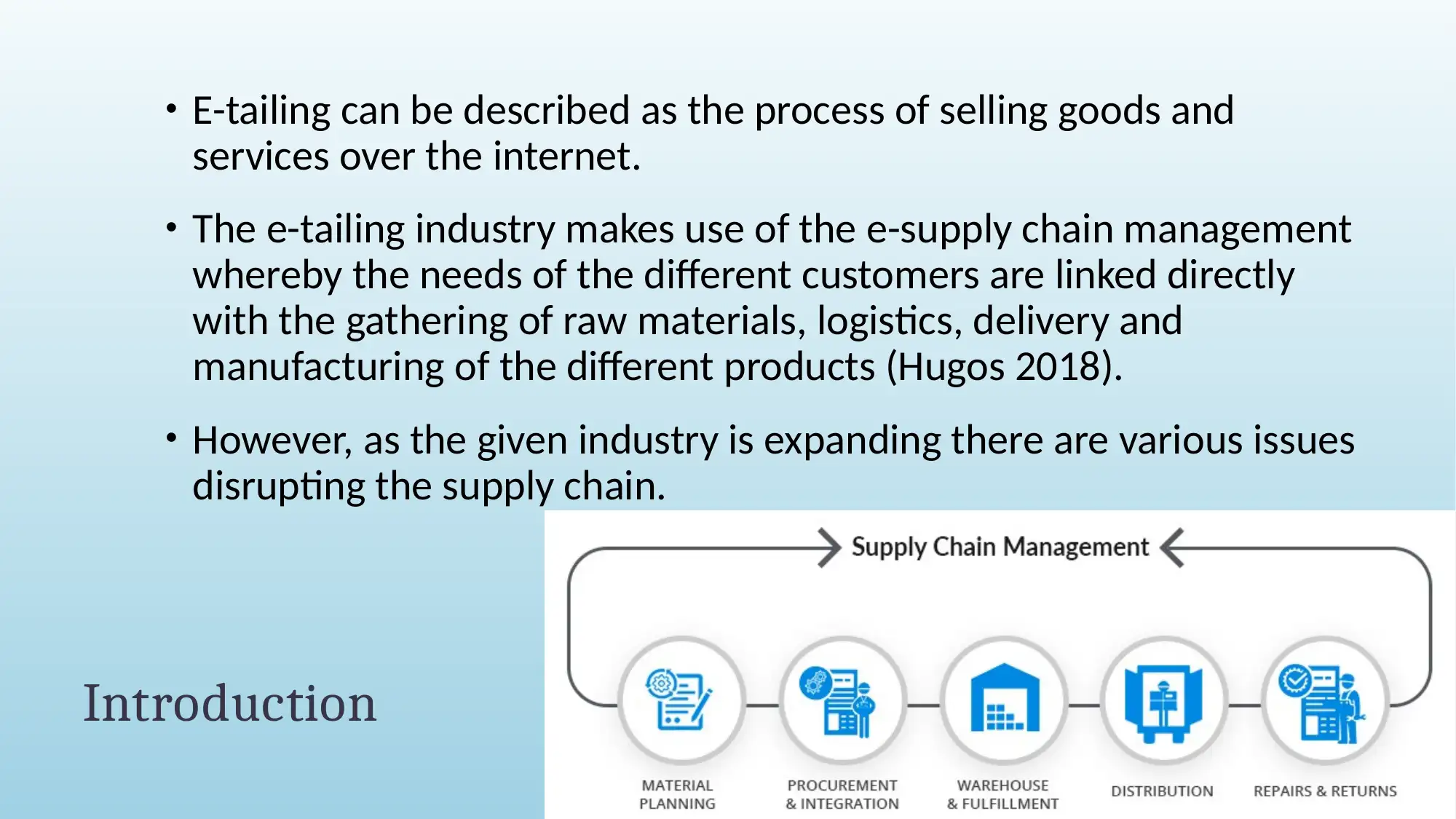
Introduction
• E-tailing can be described as the process of selling goods and
services over the internet.
• The e-tailing industry makes use of the e-supply chain management
whereby the needs of the different customers are linked directly
with the gathering of raw materials, logistics, delivery and
manufacturing of the different products (Hugos 2018).
• However, as the given industry is expanding there are various issues
disrupting the supply chain.
• E-tailing can be described as the process of selling goods and
services over the internet.
• The e-tailing industry makes use of the e-supply chain management
whereby the needs of the different customers are linked directly
with the gathering of raw materials, logistics, delivery and
manufacturing of the different products (Hugos 2018).
• However, as the given industry is expanding there are various issues
disrupting the supply chain.
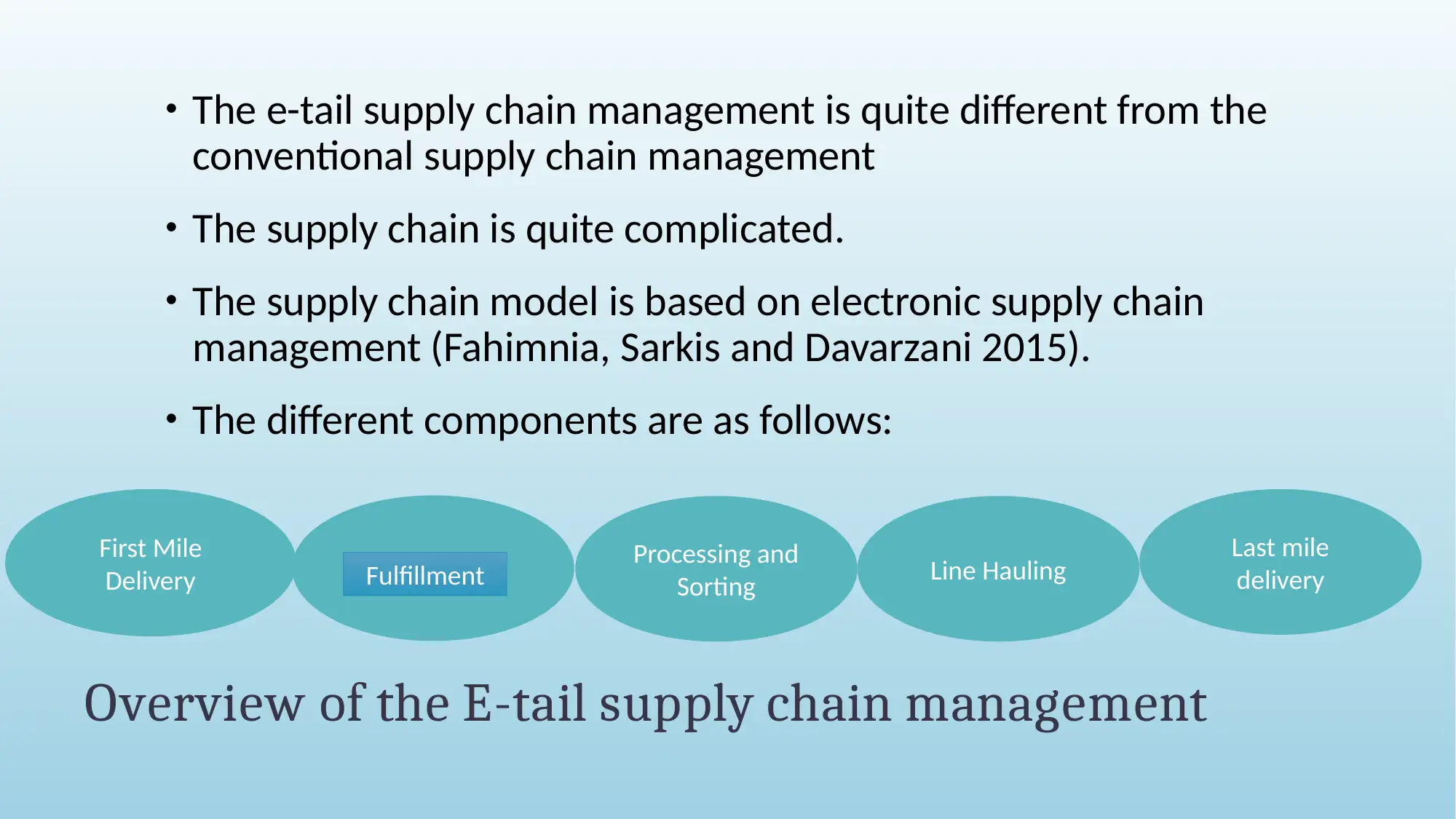
Overview of the E-tail supply chain management
• The e-tail supply chain management is quite different from the
conventional supply chain management
• The supply chain is quite complicated.
• The supply chain model is based on electronic supply chain
management (Fahimnia, Sarkis and Davarzani 2015).
• The different components are as follows:
Processing and
Sorting
Last mile
deliveryLine HaulingFulfillment
First Mile
Delivery
• The e-tail supply chain management is quite different from the
conventional supply chain management
• The supply chain is quite complicated.
• The supply chain model is based on electronic supply chain
management (Fahimnia, Sarkis and Davarzani 2015).
• The different components are as follows:
Processing and
Sorting
Last mile
deliveryLine HaulingFulfillment
First Mile
Delivery
⊘ This is a preview!⊘
Do you want full access?
Subscribe today to unlock all pages.

Trusted by 1+ million students worldwide

Components of the e-supply chain management
First Mile Delivery
The process of
making the
delivery of the
products to
different carriers
who will be
delivering the
given product.
Fulfillment
When the order is
placed on the
website, the
fulfillment team
tends to pick up
the product and
they are packed
accordingly.
Processing & Sorting
Once the delivery
of first mile is
completed then
the product is
processed and
sorted depending
the different area
they need to be
delivered.
Line Haul
The orders are
processed as the
order numbers
are huge
(Monczka et al.
2015).
Last Mile delivery
In the given step
the product is
delivered to the
given consumer
and this is the
most crucial
process in the
supply chain.
First Mile Delivery
The process of
making the
delivery of the
products to
different carriers
who will be
delivering the
given product.
Fulfillment
When the order is
placed on the
website, the
fulfillment team
tends to pick up
the product and
they are packed
accordingly.
Processing & Sorting
Once the delivery
of first mile is
completed then
the product is
processed and
sorted depending
the different area
they need to be
delivered.
Line Haul
The orders are
processed as the
order numbers
are huge
(Monczka et al.
2015).
Last Mile delivery
In the given step
the product is
delivered to the
given consumer
and this is the
most crucial
process in the
supply chain.
Paraphrase This Document
Need a fresh take? Get an instant paraphrase of this document with our AI Paraphraser

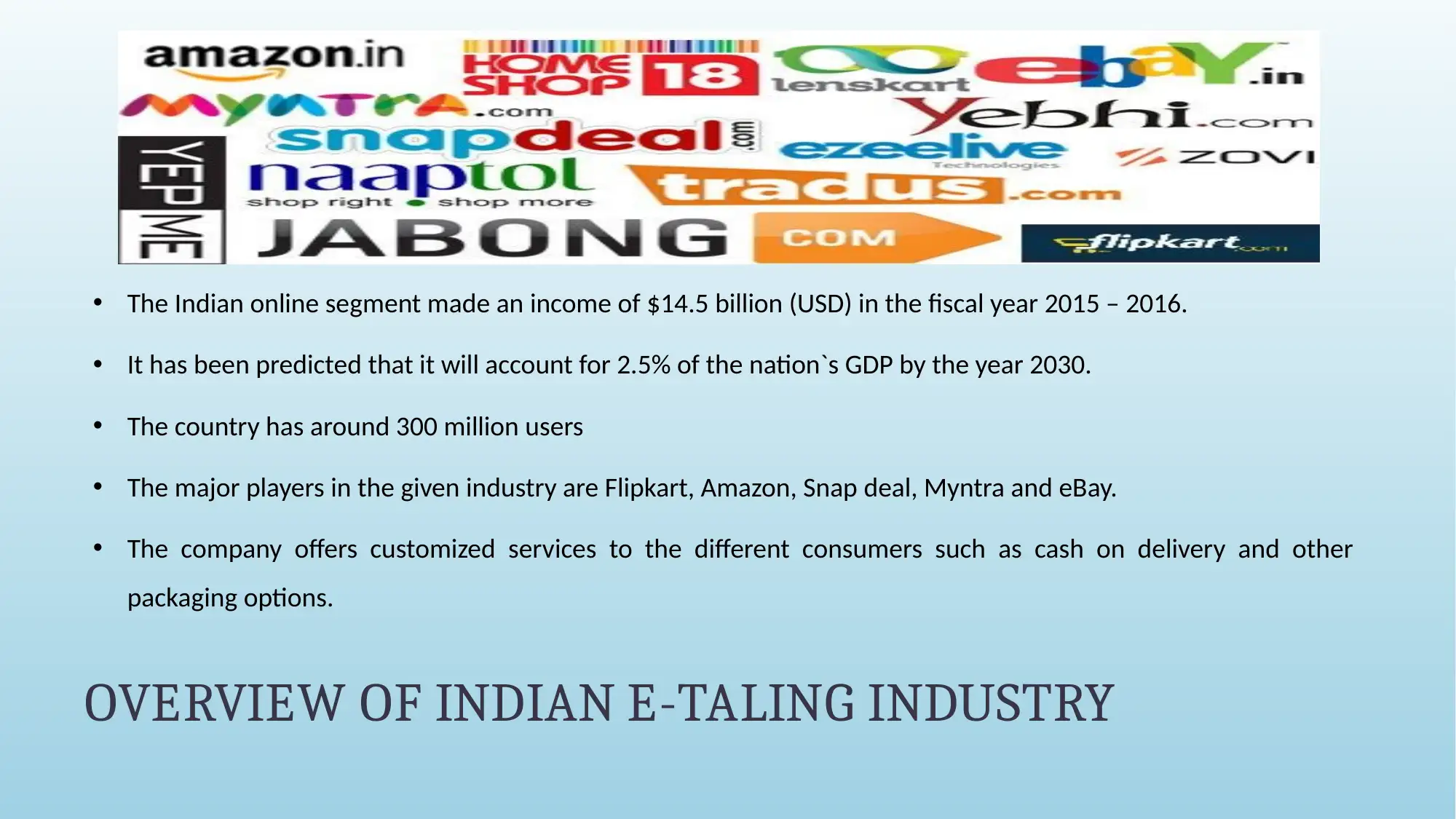
OVERVIEW OF INDIAN E-TALING INDUSTRY
• The Indian online segment made an income of $14.5 billion (USD) in the fiscal year 2015 – 2016.
• It has been predicted that it will account for 2.5% of the nation`s GDP by the year 2030.
• The country has around 300 million users
• The major players in the given industry are Flipkart, Amazon, Snap deal, Myntra and eBay.
• The company offers customized services to the different consumers such as cash on delivery and other
packaging options.
• The Indian online segment made an income of $14.5 billion (USD) in the fiscal year 2015 – 2016.
• It has been predicted that it will account for 2.5% of the nation`s GDP by the year 2030.
• The country has around 300 million users
• The major players in the given industry are Flipkart, Amazon, Snap deal, Myntra and eBay.
• The company offers customized services to the different consumers such as cash on delivery and other
packaging options.
⊘ This is a preview!⊘
Do you want full access?
Subscribe today to unlock all pages.

Trusted by 1+ million students worldwide

Last mile of Delivery
The last mile delivery refers to the last step of the supply chain management.
The given step is the most critical one and if this process is successful, the company will be able to perform well.
As the customer has a limited amount of knowledge in the given domain, the parcel delivery is important.
The customers tend to compare their products online and they tend to analyze the different aspects of the goods.
Hence, any discrepancy in what they have observed online and what has been delivered to them , causes an issue.
Companies which offer quick delivery are preferable (Jacobs, Chase and Lummus 2014).
The last mile delivery refers to the last step of the supply chain management.
The given step is the most critical one and if this process is successful, the company will be able to perform well.
As the customer has a limited amount of knowledge in the given domain, the parcel delivery is important.
The customers tend to compare their products online and they tend to analyze the different aspects of the goods.
Hence, any discrepancy in what they have observed online and what has been delivered to them , causes an issue.
Companies which offer quick delivery are preferable (Jacobs, Chase and Lummus 2014).
Paraphrase This Document
Need a fresh take? Get an instant paraphrase of this document with our AI Paraphraser

LAST MILE DELIVERY CHALLENGES IN INDIA
• The different issues in India are given as follows:
Various companies
have a no return
policy, which is very
often taken advantage
of.
The last mile delivery
tends to make the
whole supply chain
very expensive
Delivery
Returns Very often the goods
are delivered to the
wrong address or the
wrong products are
delivered.
This again tends to
lengthen the whole
process of supply
chain management
Delivery
errors
The growth of the e-
tail industry is till
quite restricted.
Lack of
technology The Cash on delivery
method is taken to be
one of the most
popular methods of
payment
Payment
method
New ways of
innovation need to
be found in order
to ensure success.
However, in many
cases this delays
the entire process
• The different issues in India are given as follows:
Various companies
have a no return
policy, which is very
often taken advantage
of.
The last mile delivery
tends to make the
whole supply chain
very expensive
Delivery
Returns Very often the goods
are delivered to the
wrong address or the
wrong products are
delivered.
This again tends to
lengthen the whole
process of supply
chain management
Delivery
errors
The growth of the e-
tail industry is till
quite restricted.
Lack of
technology The Cash on delivery
method is taken to be
one of the most
popular methods of
payment
Payment
method
New ways of
innovation need to
be found in order
to ensure success.
However, in many
cases this delays
the entire process
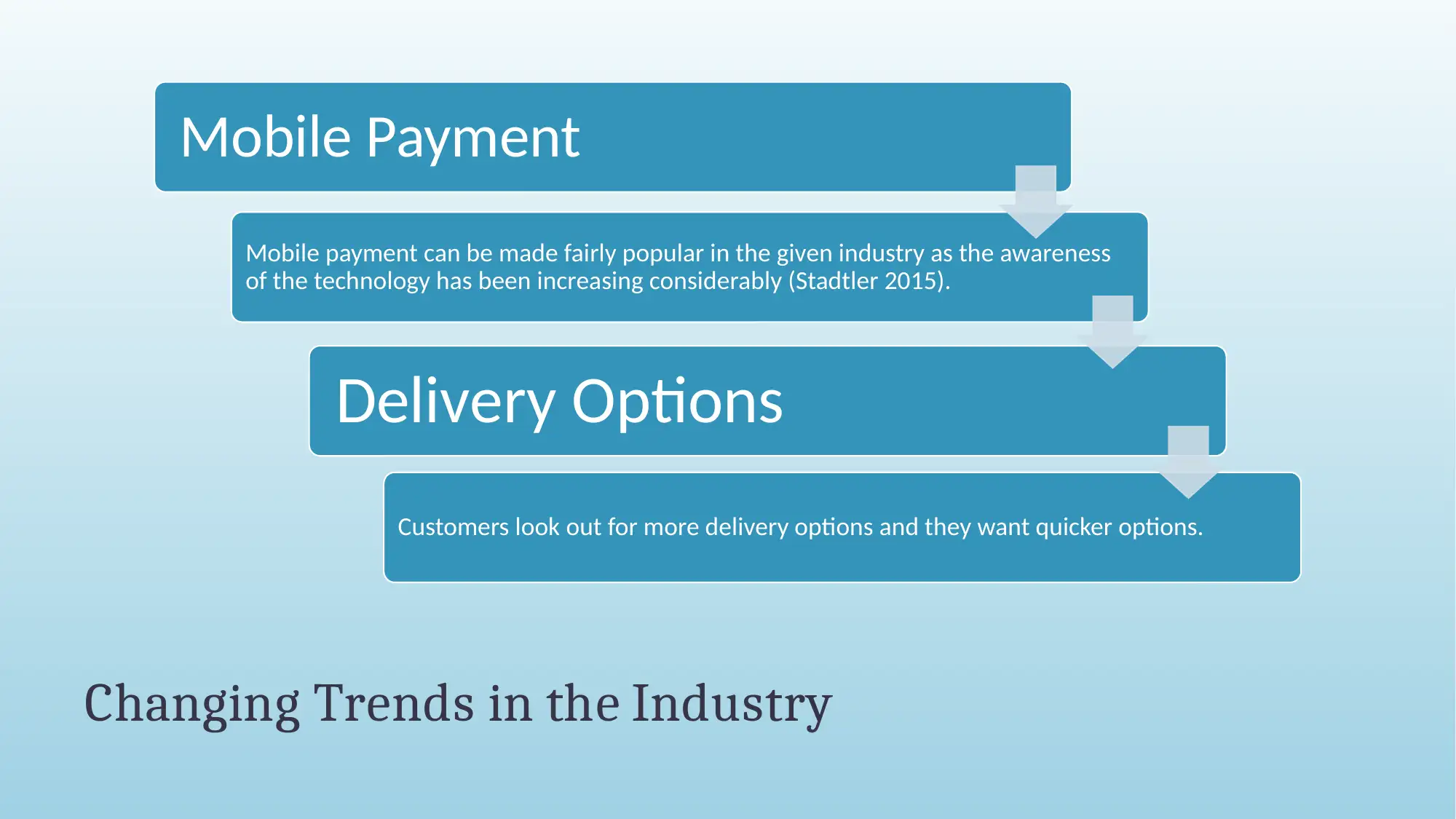
Changing Trends in the Industry
Mobile Payment
Mobile payment can be made fairly popular in the given industry as the awareness
of the technology has been increasing considerably (Stadtler 2015).
Delivery Options
Customers look out for more delivery options and they want quicker options.
Mobile Payment
Mobile payment can be made fairly popular in the given industry as the awareness
of the technology has been increasing considerably (Stadtler 2015).
Delivery Options
Customers look out for more delivery options and they want quicker options.
⊘ This is a preview!⊘
Do you want full access?
Subscribe today to unlock all pages.

Trusted by 1+ million students worldwide
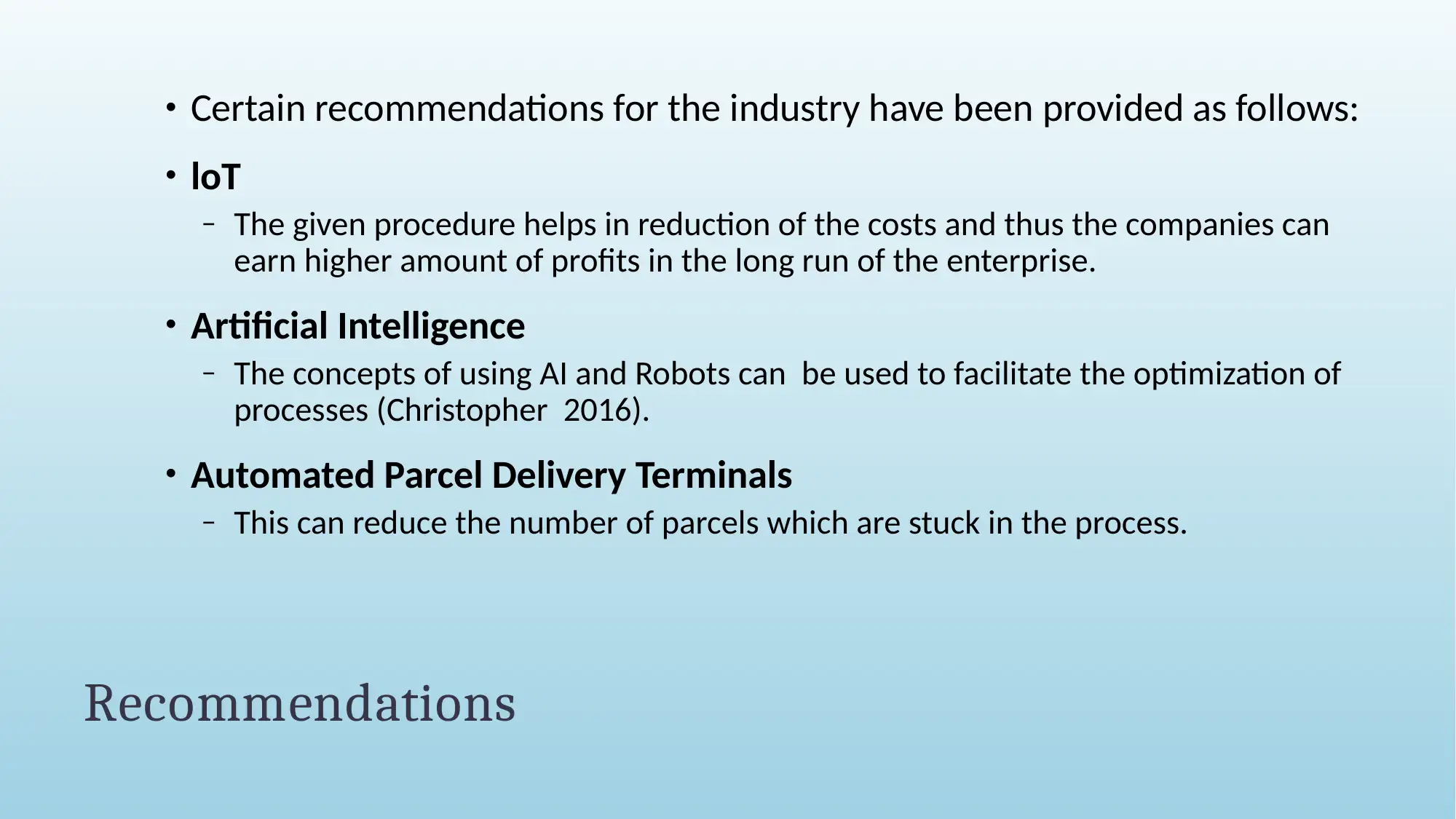
Recommendations
• Certain recommendations for the industry have been provided as follows:
• loT
– The given procedure helps in reduction of the costs and thus the companies can
earn higher amount of profits in the long run of the enterprise.
• Artificial Intelligence
– The concepts of using AI and Robots can be used to facilitate the optimization of
processes (Christopher 2016).
• Automated Parcel Delivery Terminals
– This can reduce the number of parcels which are stuck in the process.
• Certain recommendations for the industry have been provided as follows:
• loT
– The given procedure helps in reduction of the costs and thus the companies can
earn higher amount of profits in the long run of the enterprise.
• Artificial Intelligence
– The concepts of using AI and Robots can be used to facilitate the optimization of
processes (Christopher 2016).
• Automated Parcel Delivery Terminals
– This can reduce the number of parcels which are stuck in the process.
Paraphrase This Document
Need a fresh take? Get an instant paraphrase of this document with our AI Paraphraser
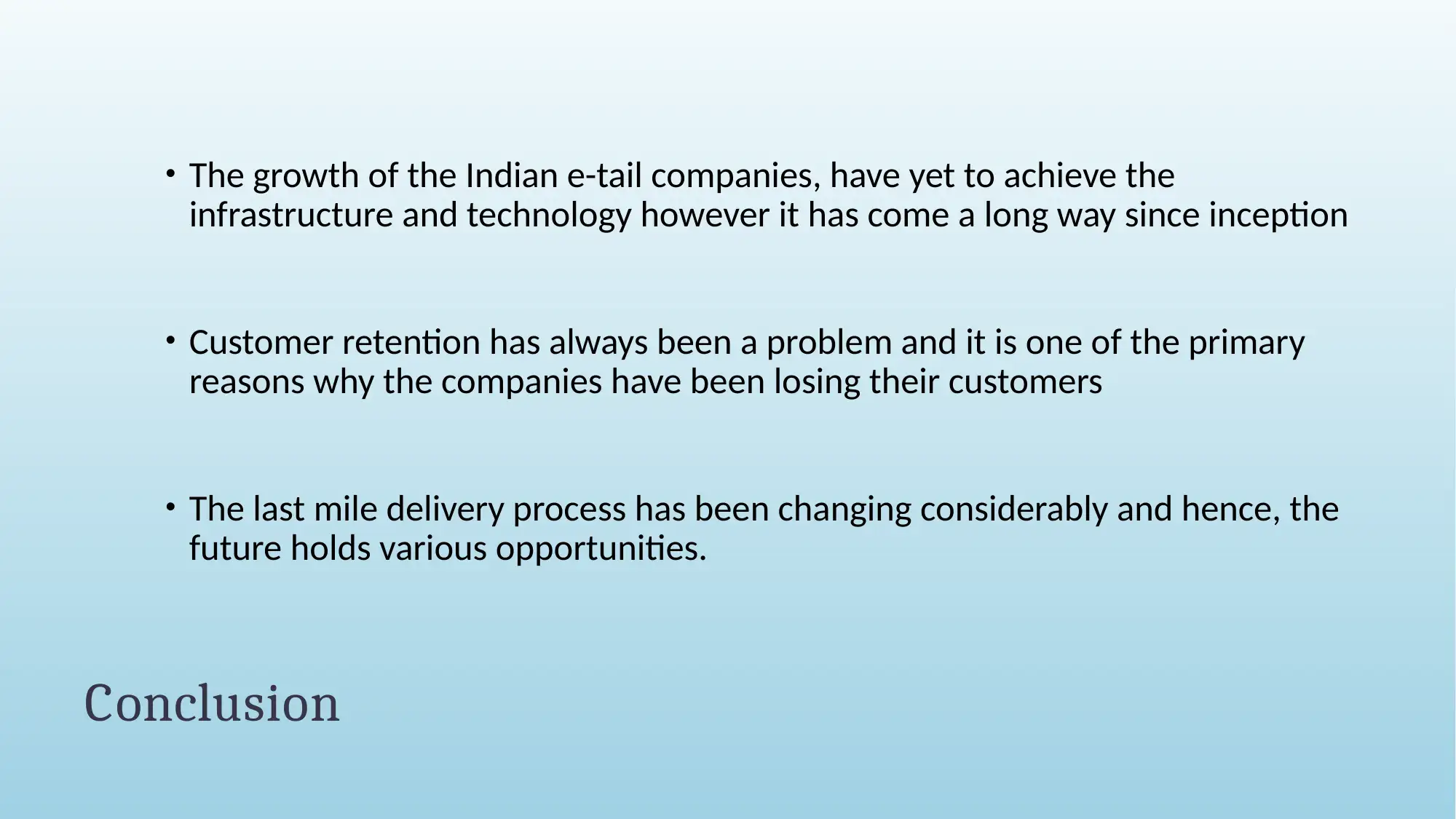
Conclusion
• The growth of the Indian e-tail companies, have yet to achieve the
infrastructure and technology however it has come a long way since inception
• Customer retention has always been a problem and it is one of the primary
reasons why the companies have been losing their customers
• The last mile delivery process has been changing considerably and hence, the
future holds various opportunities.
• The growth of the Indian e-tail companies, have yet to achieve the
infrastructure and technology however it has come a long way since inception
• Customer retention has always been a problem and it is one of the primary
reasons why the companies have been losing their customers
• The last mile delivery process has been changing considerably and hence, the
future holds various opportunities.

References
• Brindley, C. ed., 2017. Supply chain risk. Taylor & Francis.
• Christopher, M., 2016. Logistics & supply chain management. Pearson UK.
• Fahimnia, B., Sarkis, J. and Davarzani, H., 2015. Green supply chain management: A review and
bibliometric analysis. International Journal of Production Economics, 162, pp.101-114.
• Hugos, M.H., 2018. Essentials of supply chain management. John Wiley & Sons.
• Jacobs, F.R., Chase, R.B. and Lummus, R.R., 2014. Operations and supply chain
management (pp. 533-535). New York, NY: McGraw-Hill/Irwin.
• Monczka, R.M., Handfield, R.B., Giunipero, L.C. and Patterson, J.L., 2015. Purchasing and
supply chain management. Cengage Learning.
• Stadtler, H., 2015. Supply chain management: An overview. In Supply chain management and
advanced planning (pp. 3-28). Springer, Berlin, Heidelberg.
• Brindley, C. ed., 2017. Supply chain risk. Taylor & Francis.
• Christopher, M., 2016. Logistics & supply chain management. Pearson UK.
• Fahimnia, B., Sarkis, J. and Davarzani, H., 2015. Green supply chain management: A review and
bibliometric analysis. International Journal of Production Economics, 162, pp.101-114.
• Hugos, M.H., 2018. Essentials of supply chain management. John Wiley & Sons.
• Jacobs, F.R., Chase, R.B. and Lummus, R.R., 2014. Operations and supply chain
management (pp. 533-535). New York, NY: McGraw-Hill/Irwin.
• Monczka, R.M., Handfield, R.B., Giunipero, L.C. and Patterson, J.L., 2015. Purchasing and
supply chain management. Cengage Learning.
• Stadtler, H., 2015. Supply chain management: An overview. In Supply chain management and
advanced planning (pp. 3-28). Springer, Berlin, Heidelberg.
⊘ This is a preview!⊘
Do you want full access?
Subscribe today to unlock all pages.

Trusted by 1+ million students worldwide
1 out of 13
Related Documents
Your All-in-One AI-Powered Toolkit for Academic Success.
+13062052269
info@desklib.com
Available 24*7 on WhatsApp / Email
![[object Object]](/_next/static/media/star-bottom.7253800d.svg)
Unlock your academic potential
Copyright © 2020–2025 A2Z Services. All Rights Reserved. Developed and managed by ZUCOL.





